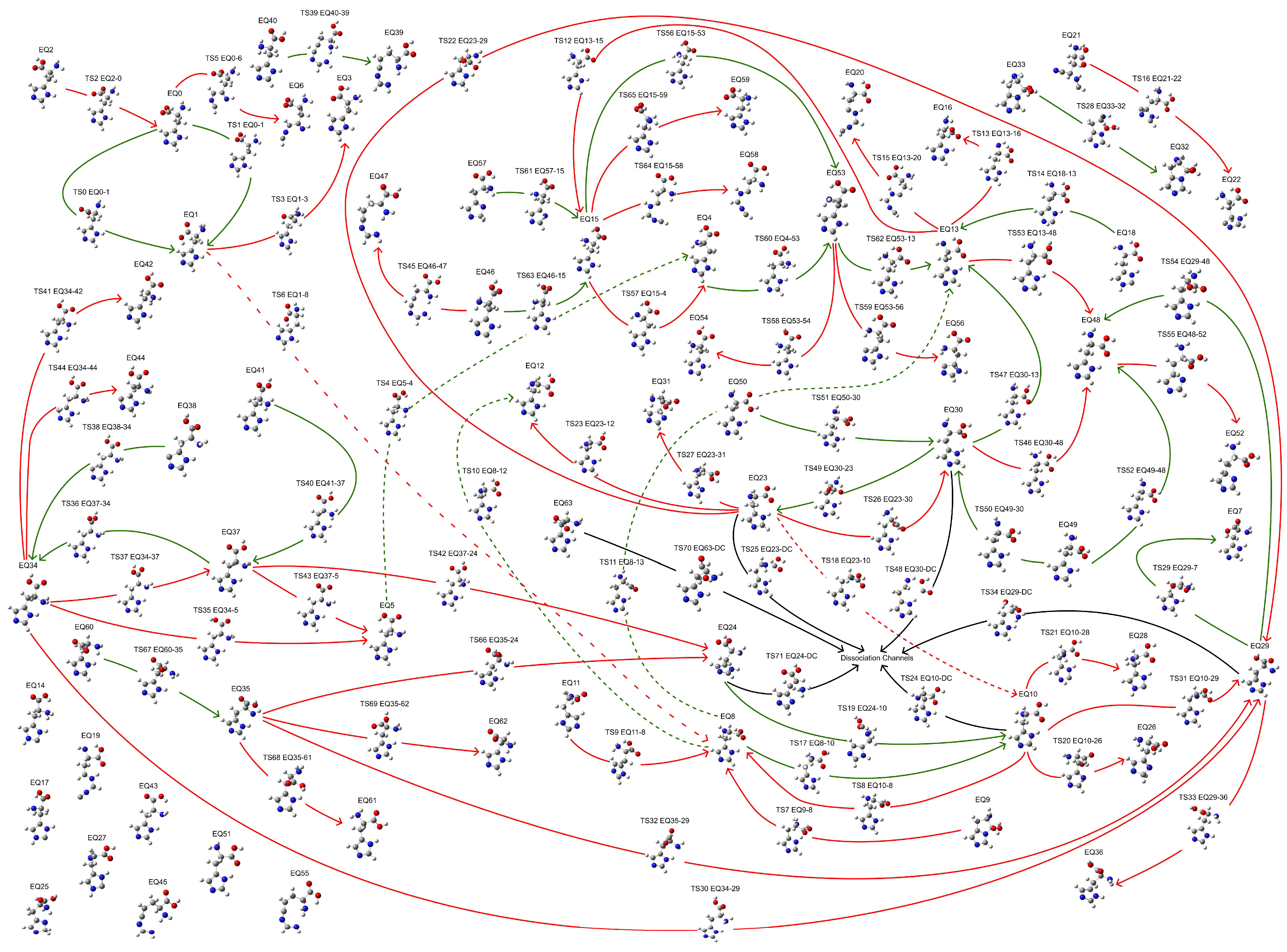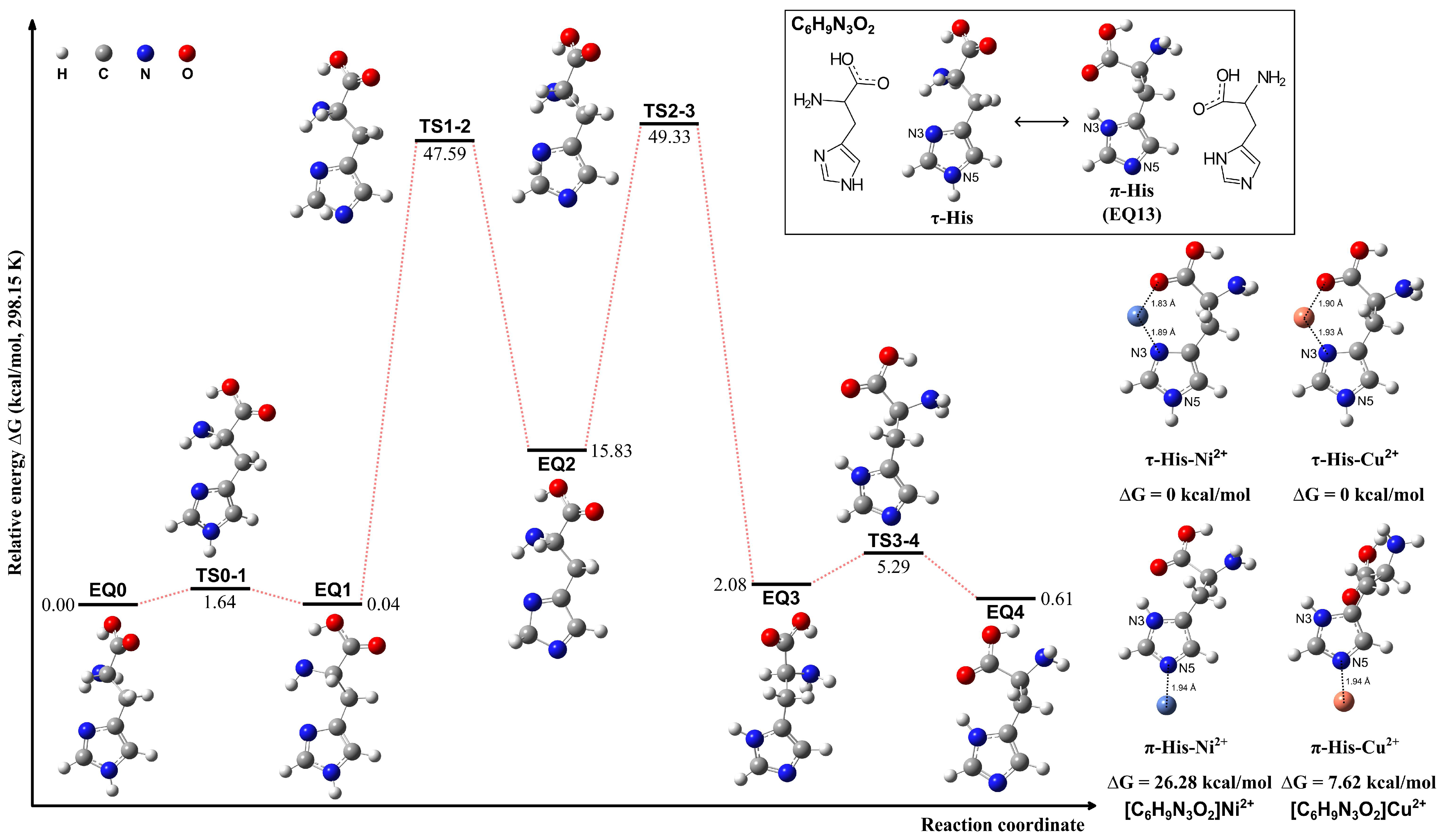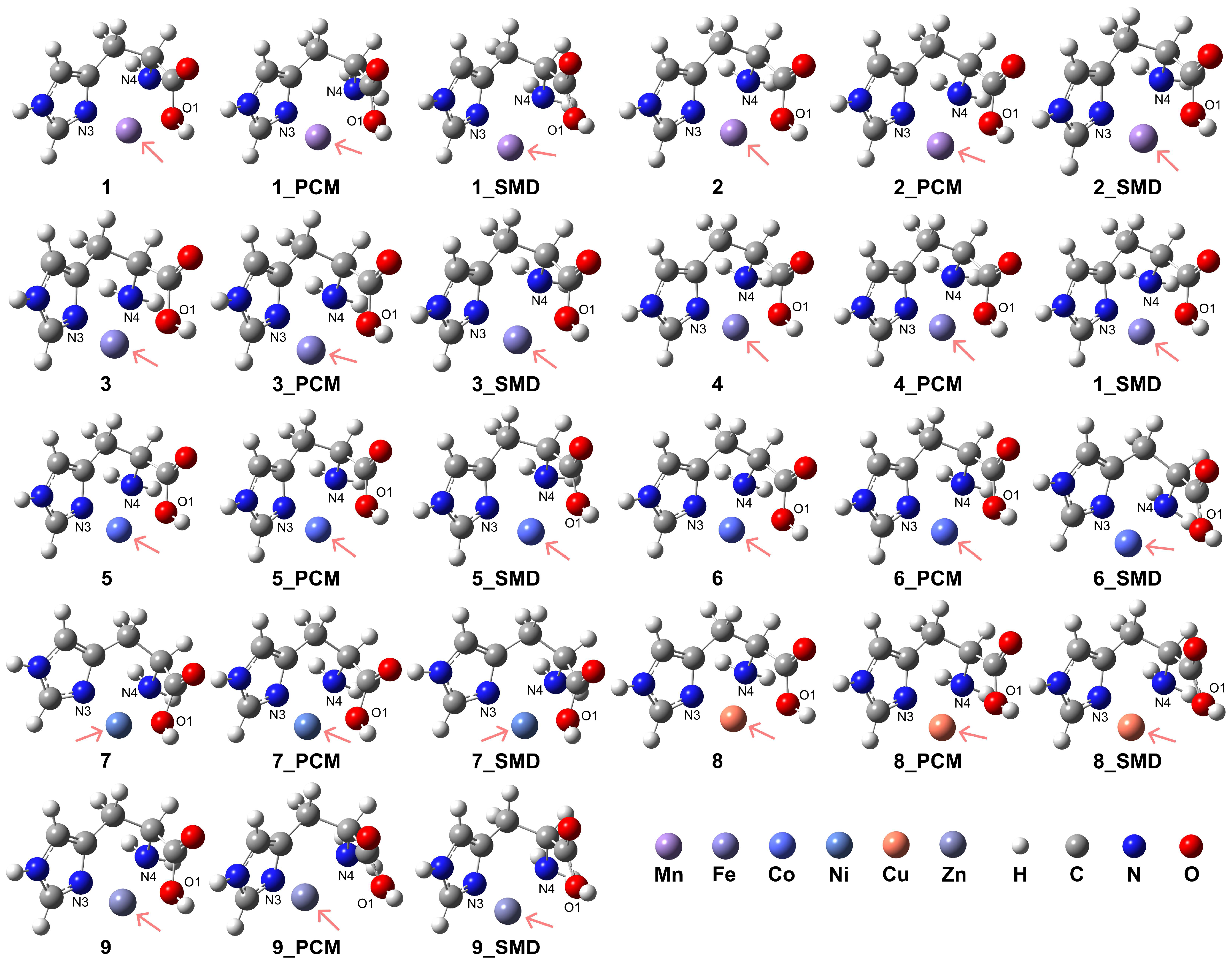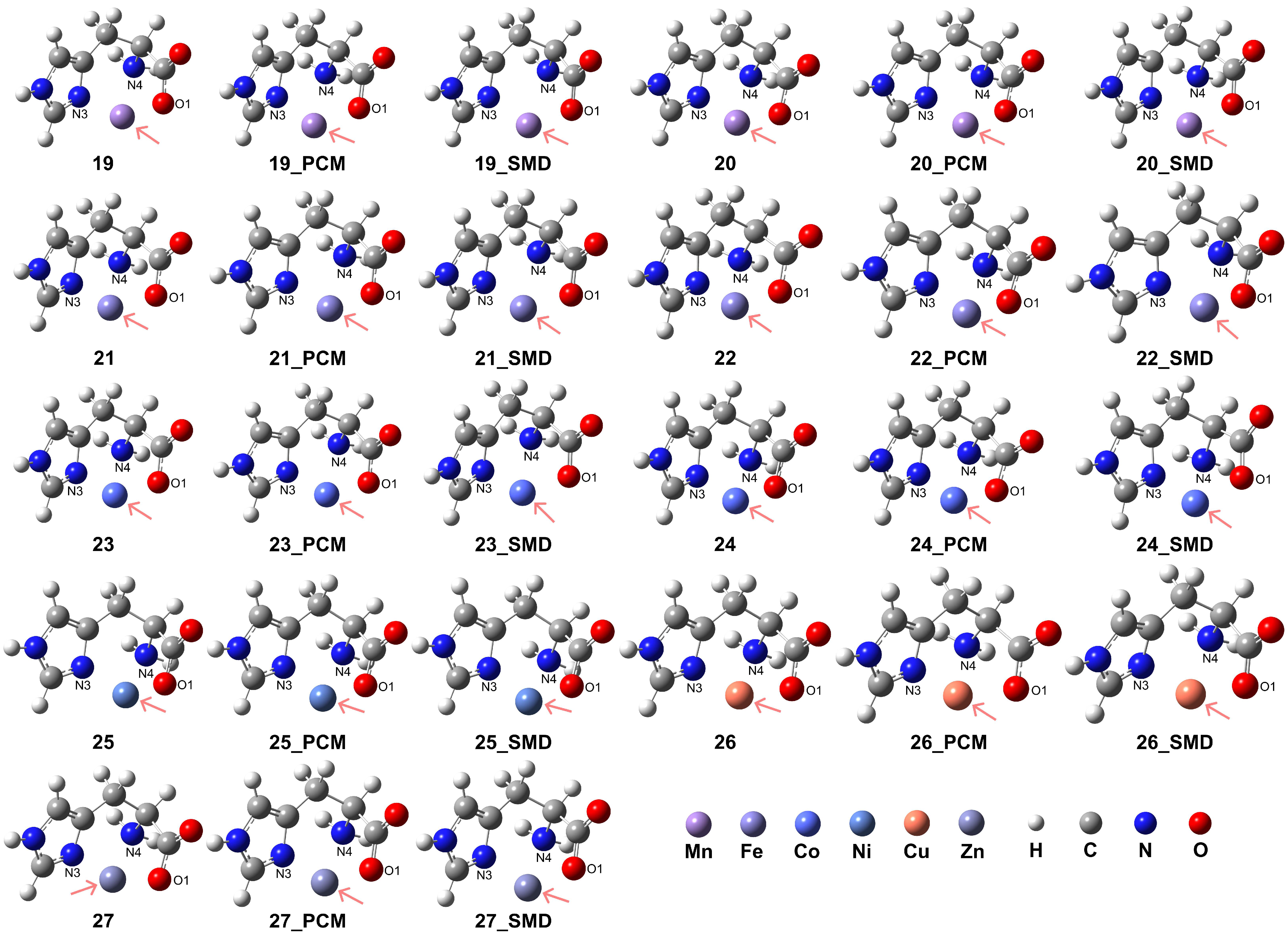Theoretical Analysis of Coordination Geometries in Transition Metal–Histidine Complexes Using Quantum Chemical Calculations
Abstract
1. Introduction
2. Results and Discussion
2.1. Conformational Changes and Coordination Sites of Histidine
2.2. Coordination Modes of His Ligand to Metal Centers ([ML]2+)
2.3. Coordination Modes of Two His Ligands to Metal Centers ([ML2]2+)
2.4. Coordiantion Modes of Deprotonated His Ligand to Metal Centers ([M(L-H)]+)
2.5. Coordiantion Modes of Two Deprotonated His Ligands to Metal Centers ([M(L-H)2])
3. Conclusions
Supplementary Materials
Author Contributions
Funding
Institutional Review Board Statement
Informed Consent Statement
Data Availability Statement
Conflicts of Interest
References
- Severin, K.; Bergs, R.; Beck, W. Bioorganometallic Chemistry—Transition Metal Complexes with α-Amino Acids and Peptides. Angew. Chem. Int. Ed. 1998, 37, 1634–1654. [Google Scholar] [CrossRef]
- Wang, Y.; R-Lazar, S.; Zhou, H.; Yin, Y.; Jiang, X.; Cai, K.; Gazit, E.; Ji, W. Bioinspired Amino Acid Based Materials in Bionanotechnology: From Minimalistic Building Blocks and Assembly Mechanism to Applications. ACS Nano 2024, 18, 1257–1288. [Google Scholar] [CrossRef] [PubMed]
- Titova, Y. Transition Metal Complexes with Amino Acids, Peptides and Carbohydrates in Catalytic Asymmetric Synthesis: A Short Review. Processes 2024, 12, 214. [Google Scholar] [CrossRef]
- Nagy, P.I. Competing Intramolecular vs. Intermolecular Hydrogen Bonds in Solution. Int. J. Mol. Sci. 2014, 15, 19562–19633. [Google Scholar] [CrossRef]
- Giubertoni, G.; Sofronov, O.O.; Bakker, H.J. Effect of intramolecular hydrogen-bond formation on the molecular conformation of amino acids. Commun. Chem. 2020, 3, 84. [Google Scholar] [CrossRef]
- Alvarez, S. Coordinating Ability of Anions, Solvents, Amino Acids, and Gases towards Alkaline and Alkaline-Earth Elements, Transition Metals, and Lanthanides. Chem. Eur. J. 2020, 26, 4350–4377. [Google Scholar] [CrossRef]
- Sóvágó, I.; Kállay, C.; Várnagy, K. Peptides as complexing agents: Factors influencing the structure and thermodynamic stability of peptide complexes. Coord. Chem. Rev. 2012, 256, 2225–2233. [Google Scholar] [CrossRef]
- Chakraborty, P.; Gazit, E. Amino Acid Based Self-Assembled Nanostructures: Complex Structures from Remarkably Simple Building Blocks. ChemNanoMat 2018, 4, 730. [Google Scholar] [CrossRef]
- Zou, Q.; Yan, X. Amino Acid Coordinated Self-Assembly. Chem. Eur. J. 2018, 24, 755. [Google Scholar] [CrossRef]
- Chakrabarty, R.; Mukherjee, P.S.; Stang, P.J. Supramolecular Coordination: Self-Assembly of Finite Two- and Three-Dimensional Ensembles. Chem. Rev. 2011, 111, 6810–6918. [Google Scholar] [CrossRef]
- Cook, T.R.; Stang, P.J. Recent Developments in the Preparation and Chemistry of Metallacycles and Metallacages via Coordination. Chem. Rev. 2015, 115, 7001–7045. [Google Scholar] [CrossRef] [PubMed]
- Hayashi, H.; Maeda, S.; Mita, T. Quantum chemical calculations for reaction prediction in the development of synthetic methodologies. Chem. Sci. 2023, 14, 11601–11616. [Google Scholar] [CrossRef] [PubMed]
- Odoh, S.O.; Cramer, C.J.; Truhlar, D.G.; Gagliardi, L. Quantum-Chemical Characterization of the Properties and Reactivities of Metal–Organic Frameworks. Chem. Rev. 2015, 115, 6051–6111. [Google Scholar] [CrossRef] [PubMed]
- Daniel, C. Photochemistry and photophysics of transition metal complexes: Quantum chemistry. Coord. Chem. Rev. 2015, 282, 19–32. [Google Scholar] [CrossRef]
- Kishimoto, N.; Waizumi, H. An automated and efficient conformation search of L-cysteine and L,L- cystine using the scaled hypersphere search method. Chem. Phys. Lett. 2017, 685, 69–76. [Google Scholar] [CrossRef]
- Kishimoto, N.; Harayama, M.; Ohno, K. An automated efficient conformation search of L-serine by the scaled hypersphere search method. Chem. Phys. Lett. 2016, 652, 209–215. [Google Scholar] [CrossRef]
- Kishimoto, N. An automated and efficient conformational search of glycine and a glycine-water heterodimer both in vacuum and in aqueous solution. Chem. Phys. Lett. 2017, 667, 172–179. [Google Scholar] [CrossRef]
- Zrilić, S.S.; Živković, J.M.; Zarić, S.D. Hydrogen bonds of a water molecule in the second coordination sphere of amino acid metal complexes: Influence of amino acid coordination. J. Inorg. Biochem. 2023, 242, 112151. [Google Scholar] [CrossRef] [PubMed]
- Zhang, D.; Kishimoto, N.; Miyake, R. Quantum Chemical Calculations of Flexible Tripeptide-Ni(II) Ion-Mediated Supramolecular Fragments and Comparative Analysis of Tripeptide Complexes with Various Metal(II) Ions. J. Phys. Chem. A 2023, 127, 9733–9742. [Google Scholar] [CrossRef]
- Marino, T.; Toscano, M.; Russo, N.; Grand, A. Structural and Electronic Characterization of the Complexes Obtained by the Interaction between Bare and Hydrated First-Row Transition-Metal Ions (Mn2+, Fe2+, Co2+, Ni2+, Cu2+, Zn2+) and Glycine. J. Phys. Chem. B 2006, 110, 24666–24673. [Google Scholar] [CrossRef]
- Shankar, R.; Kolandaivel, P.; Senthilkumar, L. Interaction studies of cysteine with Li+, Na+, K+, Be2+, Mg2+, and Ca2+ metal cation complexes. J. Phys. Org. Chem. 2011, 24, 553–567. [Google Scholar] [CrossRef]
- Pál, P.; Veres, M.; Holomb, R.; Szalóki, M.; Szöllősi, A.G.; Csarnovics, I. Identification of histidine-Ni (II) metal complex by Raman spectroscopy. J. Raman Spectrosc. 2023, 54, 278–287. [Google Scholar] [CrossRef]
- Umadevia, P.; Senthilkumar, L. Influence of metal ions (Zn2+, Cu2+, Ca2+, Mg2+ and Na+) on the water coordinated neutral and zwitterionic l-histidine dimer. RSC Adv. 2014, 4, 49040–49052. [Google Scholar] [CrossRef]
- Franklin, L.M.; Walker, S.M.; Hill, G. A DFT study of isolated histidine interactions with metal ions (Ni2+, Cu2+, Zn2+) in a six-coordinated octahedral complex. J. Mol. Model. 2020, 26, 116. [Google Scholar] [CrossRef]
- Zhou, L.; Li, S.; Su, Y.; Yi, X.; Zheng, A.; Deng, F. Interaction between Histidine and Zn(II) Metal Ions over a Wide pH as Revealed by Solid-State NMR Spectroscopy and DFT Calculations. J. Phys. Chem. B 2013, 117, 8954–8965. [Google Scholar] [CrossRef] [PubMed]
- Yoshinari, N.; Kuwamura, N.; Kojima, T.; Konno, T. Development of coordination chemistry with thiol-containing amino acids. Coord. Chem. Rev. 2023, 474, 214857. [Google Scholar] [CrossRef]
- Li, S.; Hong, M. Protonation, Tautomerization, and Rotameric Structure of Histidine: A Comprehensive Study by Magic-Angle-Spinning Solid-State NMR. J. Am. Chem. Soc. 2011, 133, 1534–1544. [Google Scholar] [CrossRef] [PubMed]
- Tang, Y.; Li, N.; Li, H.; Li, H.; Lee, J.Y. Probing the water mediated proton transfer in histidine tautomerization. J. Mol. Liq. 2023, 387, 122639. [Google Scholar] [CrossRef]
- Murphy, J.M.; Powell, B.A.; Brumaghim, J.L. Stability constants of bio-relevant, redox-active metals with amino acids: The challenges of weakly binding ligands. Coord. Chem. Rev. 2020, 412, 213253. [Google Scholar] [CrossRef]
- Deschamps, P.; Kulkarni, P.P.; Sarkar, B. X-ray Structure of Physiological Copper(II)−Bis(l-histidinato) Complex. Inorg. Chem. 2004, 43, 3338–3340. [Google Scholar] [CrossRef]
- Maeda, S.; Taketsugu, T.; Morokuma, K.; Ohno, K. Anharmonic Downward Distortion Following for Automated Exploration of Quantum Chemical Potential Energy Surfaces. Bull. Chem. Soc. Jpn. 2014, 87, 1315–1334. [Google Scholar] [CrossRef]
- Ohno, K.; Maeda, S. A Scaled Hypersphere Search Method for the Topography of Reaction Pathways on the Potential Energy Surface. Chem. Phys. Lett. 2004, 384, 277–282. [Google Scholar] [CrossRef]
- Maeda, S.; Ohno, K. Global Mapping of Equilibrium and Transition Structures on Potential Energy Surfaces by the Scaled Hypersphere Search Method: Applications to Ab Initio Surfaces of Formaldehyde and Propyne Molecules. J. Phys. Chem. A 2005, 109, 5742–5753. [Google Scholar] [CrossRef]
- Ohno, K.; Maeda, S. Global Reaction Route Mapping on Potential Energy Surfaces of Formaldehyde, Formic Acid, and their Metal Substituted Analogues. J. Phys. Chem. A 2006, 110, 8933–8941. [Google Scholar] [CrossRef]
- Becke, D. Density-functional thermochemistry. III. The role of exact exchange. J. Chem. Phys. 1993, 98, 5648–5652. [Google Scholar] [CrossRef]
- Lee, C.; Yang, W.; Parr, R.G. Development of the Colle-Salvetti correlation-energy formula into a functional of the electron density. Phys. Rev. B. 1988, 37, 785. [Google Scholar] [CrossRef] [PubMed]
- Vosko, H.; Wilk, L.; Nusair, M. Accurate spin-dependent electron liquid correlation energies for local spin density calculations: A critical analysis. Can. J. Phys. 1980, 58, 1200–1211. [Google Scholar] [CrossRef]
- Stephens, J.; Devlin, F.J.; Chabalowski, C.F.; Frisch, M.J. Ab Initio Calculation of Vibrational Absorption and Circular Dichroism Spectra Using Density Functional Force Fields. J. Phys. Chem. 1994, 98, 11623–11627. [Google Scholar] [CrossRef]
- Ditchfield, R.; Hehre, W.J.; Pople, J.A. Self-Consistent Molecular Orbital Methods. 9. Extended Gaussian-type basis for molecular-orbital studies of organic molecules. J. Chem. Phys. 1971, 54, 724–728. [Google Scholar] [CrossRef]
- Hehre, W.J.; Ditchfield, R.; Pople, J.A. Self-Consistent Molecular Orbital Methods. 12. Further extensions of Gaussian-type basis sets for use in molecular-orbital studies of organic-molecules. J. Chem. Phys. 1972, 56, 2257–2261. [Google Scholar] [CrossRef]
- Hariharan, P.C.; Pople, J.A. Influence of polarization functions on molecular-orbital hydrogenation energies. Theor. Chim. Acta 1973, 28, 213–222. [Google Scholar] [CrossRef]
- Hariharan, P.C.; Pople, J.A. Accuracy of AH equilibrium geometries by single determinant molecular-orbital theory. Mol. Phys. 1974, 27, 209–214. [Google Scholar] [CrossRef]
- Gordon, M.S. The isomers of silacyclopropane. Chem. Phys. Lett. 1980, 76, 163–168. [Google Scholar] [CrossRef]
- Francl, M.M.; Pietro, W.J.; Hehre, W.J.; Binkley, J.S.; DeFrees, D.J.; Pople, J.A.; Gordon, M.S. Self-Consistent Molecular Orbital Methods. 23. A polarization-type basis set for 2nd-row elements. J. Chem. Phys. 1982, 77, 3654–3665. [Google Scholar] [CrossRef]
- Binning, R.C., Jr.; Curtiss, L.A. Compact contracted basis-sets for 3rd-row atoms—GA-KR. J. Comp. Chem. 1990, 11, 1206–1216. [Google Scholar] [CrossRef]
- Blaudeau, J.-P.; McGrath, M.P.; Curtiss, L.A.; Radom, L. Extension of Gaussian-2 (G2) theory to molecules containing third-row atoms K and Ca. J. Chem. Phys. 1997, 107, 5016–5021. [Google Scholar] [CrossRef]
- Rassolov, V.A.; Pople, J.A.; Ratner, M.A.; Windus, T.L. 6-31G* basis set for atoms K through Zn. J. Chem. Phys. 1998, 109, 1223–1229. [Google Scholar] [CrossRef]
- Rassolov, V.A.; Ratner, M.A.; Pople, J.A.; Redfern, P.C.; Curtiss, L.A. 6-31G* Basis Set for Third-Row Atoms. J. Comp. Chem. 2001, 22, 976–984. [Google Scholar] [CrossRef]
- Frisch, M.J.; Pople, J.A.; Binkley, J.S. Self-Consistent Molecular Orbital Methods. 25. Supplementary Functions for Gaussian Basis Sets. J. Chem. Phys. 1984, 80, 3265–3269. [Google Scholar] [CrossRef]
- Maeda, S.; Harabuchi, Y.; Sumiya, Y.; Takagi, M.; Suzuki, K.; Hatanaka, M.; Osada, Y.; Taketsugu, T.; Morokuma, K.; Ohno, K. GRRM17. Available online: http://iqce.jp/GRRM/index_e.shtml (accessed on 1 May 2024).
- Maeda, S.; Ohno, K.; Morokuma, K. Systematic Exploration of the Mechanism of Chemical Reactions: The Global Reaction Route Mapping (GRRM) Strategy by the ADDF and AFIR Methods. Phys. Chem. Chem. Phys. 2013, 15, 3683–3701. [Google Scholar] [CrossRef]
- Frisch, M.J.; Trucks, G.W.; Schlegel, H.B.; Scuseria, G.E.; Robb, M.A.; Cheeseman, J.R.; Scalmani, G.; Barone, V.; Petersson, G.A.; Nakatsuji, H.; et al. Gaussian 16, Revision B.01; Gaussian, Inc.: Wallingford, UK, 2016. [Google Scholar]
- Grimme, S.; Antony, J.; Ehrlich, S.; Krieg, H. A consistent and accurate ab initio parametrization of density functional dispersion correction (DFT-D) for the 94 elements H-Pu. J. Chem. Phys. 2010, 132, 154104. [Google Scholar] [CrossRef]
- Grimme, S.; Ehrlich, S.; Goerigk, L. Effect of the damping function in dispersion corrected density functional theory. J. Comput. Chem. 2011, 32, 1456–1465. [Google Scholar] [CrossRef]
- Weigenda, F.; Ahlrichsb, R. Balanced basis sets of split valence, triple zeta valence and quadruple zeta valence quality for H to Rn: Design and assessment of accuracy. Phys. Chem. Chem. Phys. 2005, 7, 3297–3305. [Google Scholar] [CrossRef]
- Weigend, F. Accurate Coulomb-fitting basis sets for H to Rn. Phys. Chem. Chem. Phys. 2006, 8, 1057–1065. [Google Scholar] [CrossRef]
- Grimme, S.; Hansen, A.; Brandenburg, J.G.; Bannwarth, C. Dispersion-Corrected Mean-Field Electronic Structure Methods. Chem. Rev. 2016, 116, 5105–5154. [Google Scholar] [CrossRef]
- Goerigk, L.; Kruse, H.; Grimme, S. Benchmarking Density Functional Methods against the S66 and S66x8 Datasets for Non-Covalent Interactions. ChemPhysChem. 2011, 12, 3421–3433. [Google Scholar] [CrossRef]
- Bursch, M.; Mewes, J.-M.; Hansen, A.; Grimme, S. Best-Practice DFT Protocols for Basic Molecular Computational Chemistry. Angew. Chem. Int. Ed. 2022, 61, e202205735. [Google Scholar] [CrossRef]
- Tomasi, J.; Mennucci, B.; Cammi, R. Quantum mechanical continuum solvation models. Chem. Rev. 2005, 105, 2999–3094. [Google Scholar] [CrossRef]
- Marenich, A.V.; Cramer, C.J.; Truhlar, D.G. Universal solvation model based on solute electron density and a continuum model of the solvent defined by the bulk dielectric constant and atomic surface tensions. J. Phys. Chem. B 2009, 113, 6378–6396. [Google Scholar] [CrossRef]
- Maeda, S.; Ohno, K. Conversion Pathways between a Fullerene and a Ring among C20 Clusters by a Sphere Contracting Walk Method: Remarkable Difference in Local Potential Energy Landscapes around the Fullerene and the Ring. J. Chem. Phys. 2006, 124, 174306. [Google Scholar] [CrossRef]
- Maeda, S.; Ohno, K. A New Approach for Finding a Transition State Connecting a Reactant and a Product without Initial Guess: Applications of the Scaled Hypersphere Search Method to Isomerization Reactions of HCN, (H2O)2, and Alanine Dipeptide. Chem. Phys. Lett. 2005, 404, 95–99. [Google Scholar] [CrossRef]
- Johnson, E.R.; Keinan, S.; Sánchez, P.M.; García, J.C.; Cohen, A.J.; Yang, W. Revealing Noncovalent Interactions. J. Am. Chem. Soc. 2010, 132, 6498–6506. [Google Scholar] [CrossRef] [PubMed]
- Lu, T.; Chen, F. Multiwfn: A Multifunctional Wavefunction Analyzer. J. Comput. Chem. 2012, 33, 580–592. [Google Scholar] [CrossRef]
- Alvareza, S. A cartography of the van der Waals territories. Dalton Trans. 2013, 42, 8617–8636. [Google Scholar] [CrossRef] [PubMed]
- Brinck, T.; Carlqvist, P.; Stenlid, J.H. Local Electron Attachment Energy and Its Use for Predicting Nucleophilic Reactions and Halogen Bonding. J. Phys. Chem. A 2016, 120, 10023–10032. [Google Scholar] [CrossRef] [PubMed]
- Frączyk, T. Cu(II)-Binding N-Terminal Sequences of Human Proteins. Chem. Biodivers. 2021, 18, e2100043. [Google Scholar] [CrossRef]
- Badea, M.; Uivarosi, V.; Olar, R. Improvement in the Pharmacological Profile of Copper Biological Active Complexes by Their Incorporation into Organic or Inorganic Matrix. Molecules 2020, 25, 5830. [Google Scholar] [CrossRef]






| Complex | Metal Center | Charge and Spin Multiplicity | ΔG (kcal/mol, 298.15 K) | Coordination Mode | Atomic Distances of N3-M2+, N4-M2+, O1-M2+ (Å) |
|---|---|---|---|---|---|
| 1 | Mn2+ | 2, 6 (HS) | 0 | Tridentate | 2.03, 2.14, 2.15 |
| 1_PCM | −221.81 | Bidentate | 2.11, 2.20, 2.98 | ||
| 1_SMD | −257.84 | 2.17, 2.25, 3.00 | |||
| 2 | 2, 2 (LS) | 0 | Tridentate | 1.97, 2.04, 2.05 | |
| 2_PCM | −214.49 | 2.04, 2.11, 2.23 | |||
| 2_SMD | −246.66 | 2.05, 2.12, 2.32 | |||
| 3 | Fe2+ | 2, 5 (HS) | 0 | Tridentate | 1.97, 2.08, 2.09 |
| 3_PCM | −216.58 | 2.05, 2.15, 2.37 | |||
| 3_SMD | −249.35 | 2.09, 2.17, 2.33 | |||
| 4 | 2, 1 (LS) | 0 | Tridentate | 1.89, 1.95, 1.93 | |
| 4_PCM | −209.09 | 1.93, 1.97, 1.98 | |||
| 4_SMD | −238.05 | 1.93, 1.98, 2.01 | |||
| 5 | Co2+ | 2, 4 (HS) | 0 | Tridentate | 1.93, 2.05, 2.05 |
| 5_PCM | −214.69 | 2.01, 2.09, 2.36 | |||
| 5_SMD | −246.78 | 2.04, 2.12, 2.33 | |||
| 6 | 2, 2 (LS) | 0 | Tridentate | 1.88, 1.91, 2.06 | |
| 6_PCM | −210.08 | 1.90, 1.94, 2.42 | |||
| 6_SMD | −241.21 | Bidentate | 1.90, 1.94, 2.96 | ||
| 7 | Ni2+ | 2, 3 | 0 | Tridentate | 1.91, 2.00, 2.00 |
| 7_PCM | −210.77 | 1.97, 2.03, 2.16 | |||
| 7_SMD | −220.15 | 1.95, 2.01, 2.08 | |||
| 8 | Cu2+ | 2, 2 | 0 | Tridentate | 1.92, 2.00, 2.11 |
| 8_PCM | −188.23 | 1.90, 1.97, 2.35 | |||
| 8_SMD | −243.20 | Bidentate | 1.94, 1.99, 3.03 | ||
| 9 | Zn2+ | 2, 1 | 0 | Tridentate | 1.92, 2.01, 2.09 |
| 9_PCM | −220.68 | Bidentate | 1.98, 2.06, 3.37 | ||
| 9_SMD | −254.26 | 2.02, 2.07, 3.15 |
| Complex | Metal Center | Charge and Spin Multiplicity | ΔG (kcal/mol, 298.15 K) | Coordination Mode | Distances of N4-M2+, O1-M2+, N3-M2+ (Å) | Distances of N25-M2+, O23-M2+, N24-M2+ (Å) |
|---|---|---|---|---|---|---|
| 10 | Mn2+ | 2, 6 (HS) | 0 | Distorted octahedral | 2.28, 2.41, 2.17 | 2.28, 2.41, 2.17 |
| 10_PCM | −162.14 | - | 2.22, 3.50, 2.14 | 2.25, 3.52, 2.15 | ||
| 10_SMD | −191.85 | 2.25, 2.96, 2.21 | 2.27, 3.13, 2.21 | |||
| 11 | 2, 2 (LS) | 0 | Distorted octahedral | 2.12, 2.13, 2.06 | 2.12, 2.13, 2.06 | |
| 11_PCM | −155.97 | 2.10, 2.12, 2.05 | 2.10, 2.12, 2.04 | |||
| 11_SMD | −180.76 | - | 2.10, 3.02, 2.06 | 2.10, 3.01, 2.07 | ||
| 12 | Fe2+ | 2, 5 (HS) | 0 | Distorted octahedral | 2.24, 2.27, 2.11 | 2.23, 2.34, 2.13 |
| 12_PCM | −160.80 | - | 2.17, 3.46, 2.06 | 2.17, 3.39, 2.06 | ||
| 12_SMD | −188.95 | 2.18, 3.10, 2.10 | 2.19, 3.09, 2.11 | |||
| 13 | 2, 1 (LS) | 0 | Octahedral | 2.06, 2.03, 2.02 | 2.06, 2.03, 2.02 | |
| 13_PCM | −156.69 | Distorted octahedral | 2.04, 2.02, 2.00 | 2.04, 2.03, 2.00 | ||
| 13_SMD | −177.56 | Octahedral | 2.04, 2.02, 2.00 | 2.04, 2.02, 2.00 | ||
| 14 | Co2+ | 2, 4 (HS) | 0 | Octahedral | 2.19, 2.24, 2.10 | 2.19, 2.24, 2.10 |
| 14_PCM | −165.09 | - | 2.10, 3.46, 2.01 | 2.11, 3.48, 2.01 | ||
| 14_SMD | −190.57 | 2.10, 3.12, 2.04 | 2.12, 3.41, 2.03 | |||
| 15 | 2, 2 (LS) | 0 | Distorted octahedral | 2.02, 2.40, 1.97 | 2.02, 2.41, 1.97 | |
| 15_PCM | −156.80 | 2.01, 2.35, 1.96 | 2.01, 2.35, 1.96 | |||
| 15_SMD | −179.80 | - | 2.00, 2.76, 1.98 | 2.00, 2.94, 1.97 | ||
| 16 | Ni2+ | 2, 3 | 0 | Distorted octahedral | 2.16, 2.23, 2.08 | 2.16, 2.24, 2.08 |
| 16_PCM | −155.25 | 2.14, 2.26, 2.07 | 2.14, 2.26, 2.07 | |||
| 16_SMD | −176.98 | 2.13, 2.27, 2.07 | 2.13, 2.27, 2.07 | |||
| 17 | Cu2+ | 2, 2 | 0 | - | 2.09, 3.34, 1.97 | 2.07, 2.37, 2.03 |
| 17_PCM | −149.58 | 2.06, 2.84, 1.99 | 2.05, 2.50, 2.02 | |||
| 17_SMD | −175.83 | 2.07, 3.00, 2.01 | 2.04, 2.93, 2.03 | |||
| 18 | Zn2+ | 2, 1 | 0 | - | 2.10, 3.56, 1.99 | 2.10, 3.56, 1.99 |
| 18_PCM | −158.65 | 2.10, 3.45, 2.02 | 2.11, 3.47, 2.02 | |||
| 18_SMD | −184.42 | 2.12, 3.43, 2.05 | 2.11, 3.26, 2.06 |
| Complex | Metal Center | Charge and Spin Multiplicity | ΔG (kcal/mol, 298.15 K) | Coordination Mode | Distances of N3-M2+, N4-M2+, O1-M2+ (Å) |
|---|---|---|---|---|---|
| 19 | Mn2+ | 1, 6 (HS) | 0 | 2.08, 2.17, 1.92 | |
| 19_PCM | −93.39 | Tridentate | 2.16, 2.22, 2.08 | ||
| 19_SMD | −119.16 | 2.19, 2.26, 2.18 | |||
| 20 | 1, 2 (LS) | 0 | 2.00, 2.05, 1.85 | ||
| 20_PCM | −84.73 | Tridentate | 2.04, 2.09, 1.99 | ||
| 20_SMD | −108.40 | 2.08, 2.11, 2.06 | |||
| 21 | Fe2+ | 1, 5 (HS) | 0 | 2.02, 2.12, 1.86 | |
| 21_PCM | −85.64 | Tridentate | 2.08, 2.16, 1.98 | ||
| 21_SMD | −110.15 | 2.12, 2.19, 2.06 | |||
| 22 | 1, 1 (LS) | 0 | Tridentate | 1.90, 1.95, 1.81 | |
| 22_PCM | −81.45 | 1.92, 1.96, 1.89 | |||
| 22_SMD | −101.77 | 1.93, 1.97, 1.92 | |||
| 23 | Co2+ | 1, 4 (HS) | 0 | Tridentate | 1.99, 2.07, 1.85 |
| 23_PCM | −85.35 | 2.03, 2.11, 1.97 | |||
| 23_SMD | −109.29 | 2.08, 2.13, 2.06 | |||
| 24 | 1, 2 (LS) | 0 | Tridentate | 1.96, 2.00, 1.79 | |
| 24_PCM | −77.51 | 2.00, 2.02, 1.84 | |||
| 24_SMD | −99.29 | 1.93, 1.92, 2.09 | |||
| 25 | Ni2+ | 1, 3 | 0 | Tridentate | 1.94, 2.01, 1.85 |
| 25_PCM | −83.07 | 1.98, 2.03, 1.95 | |||
| 25_SMD | −88.11 | 1.97, 2.01, 1.96 | |||
| 26 | Cu2+ | 1, 2 | 0 | Tridentate | 1.97, 2.00, 1.87 |
| 26_PCM | −64.37 | 1.95, 1.98, 1.92 | |||
| 26_SMD | −98.13 | 2.06, 1.97, 2.09 | |||
| 27 | Zn2+ | 1, 1 | 0 | Tridentate | 1.97, 2.06, 1.89 |
| 27_PCM | −89.92 | 2.02, 2.09, 2.03 | |||
| 27_SMD | −113.68 | 2.08, 2.11, 2.06 |
| Complex | Metal Center | Charge and Spin Multiplicity | ΔG (kcal/mol, 298.15 K) | Coordination Mode | Distances of N4-M2+, O1-M2+, N3-M2+ (Å) | Distances of N24-M2+, O21-M2+, N23-M2+ (Å) |
|---|---|---|---|---|---|---|
| 28 | Mn2+ | 0, 6 (HS) | 0 | Distorted octahedral | 2.34, 2.12, 2.27 | 2.34, 2.12, 2.27 |
| 28_PCM | −34.35 | 2.31, 2.18, 2.25 | 2.30, 2.18, 2.25 | |||
| 28_SMD | −50.26 | 2.31, 2.31, 2.28 | 2.30, 2.29, 2.32 | |||
| 29 | 0, 2 (LS) | 0 | Distorted octahedral | 2.10, 1.99, 2.03 | 2.10, 1.99, 2.03 | |
| 29_PCM | −33.16 | 2.10, 2.02, 2.05 | 2.10, 2.02, 2.05 | |||
| 29_SMD | −50.29 | 2.12, 2.08, 2.07 | 2.12, 2.08, 2.07 | |||
| 30 | Fe2+ | 0, 5 (HS) | 0 | Distorted octahedral | 2.29, 2.03, 2.21 | 2.29, 2.04, 2.21 |
| 30_PCM | −32.28 | 2.25, 2.09, 2.20 | 2.25, 2.09, 2.20 | |||
| 30_SMD | −47.59 | 2.25, 2.16, 2.20 | 2.23, 2.19, 2.21 | |||
| 31 | 0, 1 (LS) | 0 | Distorted octahedral | 2.04, 1.98, 1.99 | 2.04, 1.98, 1.99 | |
| 31_PCM | −33.89 | 2.04, 2.01, 2.01 | 2.04, 2.00, 2.01 | |||
| 31_SMD | −47.87 | 2.04, 2.02, 2.01 | 2.04, 2.02, 2.01 | |||
| 32 | Co2+ | 0, 4 (HS) | 0 | Distorted octahedral | 2.22, 2.03, 2.16 | 2.22, 2.03, 2.16 |
| 32_PCM | −33.85 | 2.20, 2.09, 2.15 | 2.20, 2.09, 2.15 | |||
| 32_SMD | −48.63 | 2.19, 2.16, 2.15 | 2.20, 2.15, 2.14 | |||
| 33 | 0, 2 (LS) | 0 | Distorted octahedral | 2.28, 1.95, 1.97 | 2.00, 1.93, 2.44 | |
| 33_PCM | −33.96 | 2.01, 2.25, 1.98 | 2.01, 2.25, 1.98 | |||
| 33_SMD | −50.40 | 2.00, 2.29, 1.98 | 2.00, 2.29, 1.98 | |||
| 34 | Ni2+ | 0, 3 | 0 | Distorted octahedral | 2.15, 2.04, 2.10 | 2.15, 2.04, 2.10 |
| 34_PCM | −35.41 | 2.14, 2.09, 2.10 | 2.14, 2.09, 2.10 | |||
| 34_SMD | −49.63 | 2.12, 2.11, 2.10 | 2.12, 2.12, 2.10 | |||
| 35 | Cu2+ | 0, 2 | 0 | - | 2.05, 1.95, 2.96 | 2.41, 1.98, 2.03 |
| 35_PCM | −31.00 | 2.04, 1.98, 3.23 | 2.30, 2.01, 2.01 | |||
| 35_SMD | −54.38 | 2.04, 2.00, 3.72 | 2.05, 3.96, 1.99 | |||
| 36 | Zn2+ | 0, 1 | 0 | Distorted octahedral | 2.24, 2.04, 2.20 | 2.24, 2.04, 2.20 |
| 36_PCM | −34.00 | 2.21, 2.13, 2.16 | 2.21, 2.13, 2.16 | |||
| 36_SMD | −50.38 | 2.16, 2.39, 2.15 | 2.19, 2.24, 2.14 |
Disclaimer/Publisher’s Note: The statements, opinions and data contained in all publications are solely those of the individual author(s) and contributor(s) and not of MDPI and/or the editor(s). MDPI and/or the editor(s) disclaim responsibility for any injury to people or property resulting from any ideas, methods, instructions or products referred to in the content. |
© 2024 by the authors. Licensee MDPI, Basel, Switzerland. This article is an open access article distributed under the terms and conditions of the Creative Commons Attribution (CC BY) license (https://creativecommons.org/licenses/by/4.0/).
Share and Cite
Zhang, D.; Kishimoto, N. Theoretical Analysis of Coordination Geometries in Transition Metal–Histidine Complexes Using Quantum Chemical Calculations. Molecules 2024, 29, 3003. https://doi.org/10.3390/molecules29133003
Zhang D, Kishimoto N. Theoretical Analysis of Coordination Geometries in Transition Metal–Histidine Complexes Using Quantum Chemical Calculations. Molecules. 2024; 29(13):3003. https://doi.org/10.3390/molecules29133003
Chicago/Turabian StyleZhang, Dapeng, and Naoki Kishimoto. 2024. "Theoretical Analysis of Coordination Geometries in Transition Metal–Histidine Complexes Using Quantum Chemical Calculations" Molecules 29, no. 13: 3003. https://doi.org/10.3390/molecules29133003
APA StyleZhang, D., & Kishimoto, N. (2024). Theoretical Analysis of Coordination Geometries in Transition Metal–Histidine Complexes Using Quantum Chemical Calculations. Molecules, 29(13), 3003. https://doi.org/10.3390/molecules29133003








